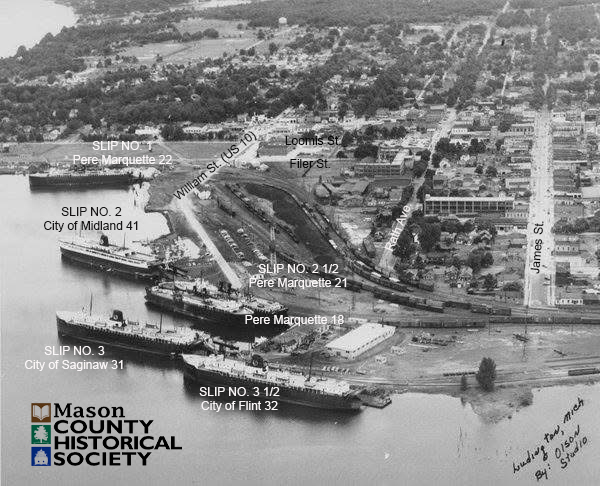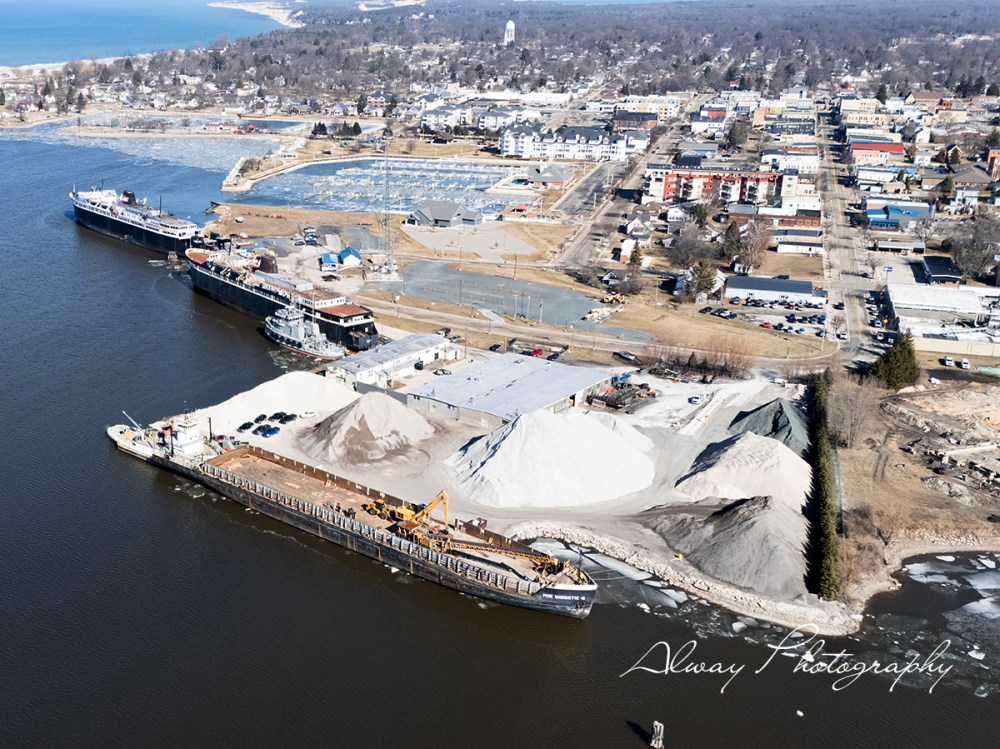Why is the SS Badger’s Ludington berth called Slip No. 2?


Modern view of the carferry docks
In the early 1930s, the Ludington cross lake car ferry fleet consisted of nine ships that operated 24 hours a day, seven days a week, 365 days a year, transporting mostly rail freight from Ludington, Michigan to the Wisconsin ports of Manitowoc, Milwaukee and Kewaunee. For that fleet of nine boats, there were three docks (or slips) that the ships would back into and connect to railroad tracks — Slip No. 1, Slip No. 2, and Slip No. 3. Slips 2 and 3 also included ramps to load automobiles to the upper auto deck of the SS City of Midland 41, SS. Spartan and SS Badger.
Between the whole numbered slips were Slip No. 2 1/2 and Slip No. 3/12. The “half” slips did not have access to railroad tracks or auto ramps. Slip No. 2 1/2 was often referred to as “Misery Bay” by car ferry crew, according to Don Klemm, who worked on the ferries in the 1970s and whose father, Bill Klemm, who served as C&O Railroad superintendent of steamships from 1975 until his retirement in 1979 (Bill Klemm began working at the ferries in 1941). “That’s where a lot of the retired boats were tied up.”
 Slip No. 1 was located near the intersection of William and Filer streets (upper part of the photo). In the modern photo, that is now just south of the Ludington Municipal Marina and the west side of Waterfront Park. No. 2 Slip is the present-day home of the Badger, as stated above. Slip No. 2 1/2 is just to the southeast and has been where the Spartan has been tied-up since 1979. Slip No. 3 was located just south of Slip 2 1/2, located behind the modern Lake Michigan Carferry warehouse (the building closest to the Spartan in the modern photo). Slip No. 3 1/2 was located approximately where the Undaunted/Pere Marquette 41tug/barge moors. In the modern photo, the slip was a little closer to the building where the limestone pile is located.
Slip No. 1 was located near the intersection of William and Filer streets (upper part of the photo). In the modern photo, that is now just south of the Ludington Municipal Marina and the west side of Waterfront Park. No. 2 Slip is the present-day home of the Badger, as stated above. Slip No. 2 1/2 is just to the southeast and has been where the Spartan has been tied-up since 1979. Slip No. 3 was located just south of Slip 2 1/2, located behind the modern Lake Michigan Carferry warehouse (the building closest to the Spartan in the modern photo). Slip No. 3 1/2 was located approximately where the Undaunted/Pere Marquette 41tug/barge moors. In the modern photo, the slip was a little closer to the building where the limestone pile is located.
The black and white photo was taken by Olson Studio in 1952, when the biggest strike in the history of the car ferries occurred when members of the Great Lakes Licensed Officers’ Organization walked off the job. The strike lasted for 114 days. Based on the foliage, the photo was taken in the summer. It shows the six ferries that were part of the fleet at the time. Not shown is the Spartan, which arrived in October of that year, just as the strike was ending. Also not shown is the Badger, which was still under construction at that time in Sturgeon Bay, Wisconsin. The Badger made her maiden voyage out of Ludington in March 1953. Once the Badger and Spartan arrived, the ferry fleet was increased to eight ships for a short time.
Because of the strike, the photographer captured a rare moment in time, when all six ferries were docked. Typically, the ferries were on the constant move.
Shown in the photo, berthed at Slip No. 1 is Pere Marquette 22; No. 2, City of Midland 41; Slip No. 2 1/2 Pere Marquette 18, lake side, tied to Pere Marquette 21 against shore; Slip No. 3, City of Saginaw 31; and Slip No. 3 1/2, City of Flint 32.
Comparing the two photos: The black and white image was taken at a higher altitude from an airplane while the color picture was taken in February 2025 with a drone at 400 feet. As a point of reference, James Street is on the far right side of both images. Notice in the black and white photo that James Street ends at the railroad tracks. Prior to the development of Waterfront Park in the 1990s, William Street was the designated US 10 route from Ludington Avenue to the car ferry docks, its Michigan western terminus. Today, US 10 is designated on James Street, ending its western Michigan route along Maritime Drive at the Badger.
Black and white photograph and information from the Mason County Historical Society, operator of the Port of Ludington Maritime Museum. Additional assistance from Don Klemm of Ludington.
_____________________
Lake Michigan Carferry operates the S.S. Badger, the largest cross-lake passenger and car ferry service on the Great Lakes. Designated a National Historic Landmark, the Badger is a key part of US-10 highway connecting the cities of Ludington, Mich., and Manitowoc, Wis. A vital link across Lake Michigan, the Badger can accommodate 600 passengers and 180 vehicles, including RVs, motorcycles, motorcoaches, and commercial trucks and oversized loads in one single trip. www.ssbadger.com
Interlake Maritime Services is a family of companies with nearly 300 years of collective service on the Great Lakes. A family-owned and -led company in its second generation, Interlake Maritime and its more than 50 shoreside employees manage The Interlake Steamship Company, Interlake Logistics Solutions, Lake Michigan Carferry, Soo Maritime Services and Interlake Port Services from its corporate headquarters in Middleburg Heights, a suburb of Cleveland, Ohio, and additional regional offices in Ludington, Mich., and Sault Sainte Marie, Mich. www.interlakemaritimeservices.com
